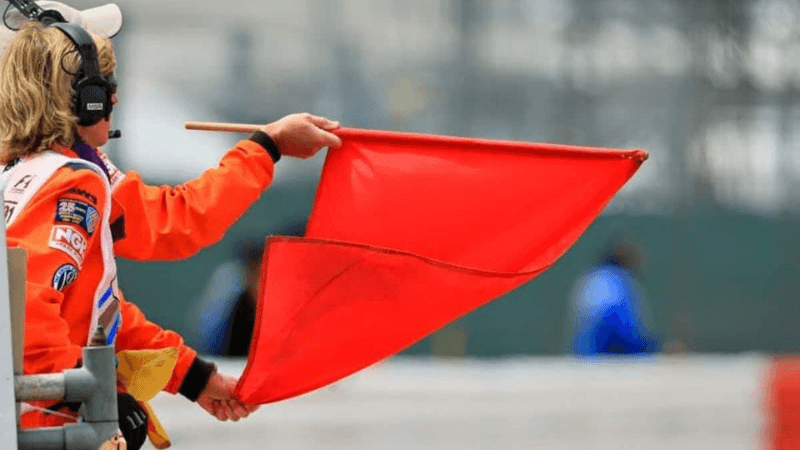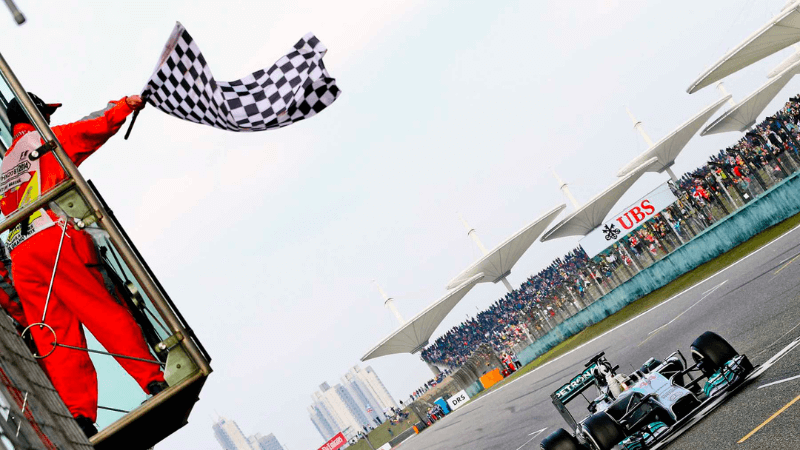Are you wondering what go-kart racing flags signify in karting? If you do, this article will unmask the reasons behind each flag used in Go-karting.
Flags play a significant role in Go-karting circuits as they offer different indications to drivers during a race. Each flag serves a different purpose, allowing drivers and other officials to conduct Go-kart races safely. In short, officials use these flags to convey their messages without disturbing the race.
In this post, I will provide a detailed overview of the seven types of flags used in go-kart racing, including their significance, purpose, and usage instructions.
Table of Contents
ToggleTypes Of Go-Kart Racings Flags And Their Color Meanings
As mentioned earlier, go-kart racing employs seven different flags during a race. Although each flag serves a different purpose, its core functionality allows officials to send signals to go-kart drivers on the race track.
Here are the different flags used in go-kart racing.
Green Flag

Purpose and significance
As mentioned, a green flag works on the same principles as traffic lights, where green means it’s good to go. So, when the race official waves a green flag, drivers understand that it is a green signal for go.
The green flag also signals a restart after a caution period and can have multiple usages depending on the racing parameters for different tracks.
Likewise, waving a green flag also symbolizes safety on a race track. So, if you see a race official waving a green flag, you can determine that the race track is clear and safe for the race.
Where can you expect a green flag?
A track official will wave a green flag to mark the beginning of a race. However, you can witness green flags at the start and finish line on some race tracks.
What should you do when you see a green flag being waved?
Waving a green flag translates to starting a race. So, when you see a green flag waving, you should accelerate and begin racing. However, ensure that you maintain situational awareness and take precautions during racing.
Yellow Flag

The Yellow flag symbolizes potential hazards and allows drivers to determine the track condition in advance. In short, you can prepare and take evasive actions during a race.
Purpose and Significance
The yellow flag plays a crucial role in driver safety as track officials warn drivers about potential hazards or unsafe track conditions. So, whenever you see a yellow flag being waved by a track official, it would be best to slow down and proceed cautiously.
Where can you expect a yellow flag?
Most go-kart racing tracks have yellow flags at strategic locations to alert drivers. However, you may also witness track officials waving yellow flags at various locations around the track.
What should you do when you see a yellow flag being waved?
When you see a yellow flag, it is a sign that you should reduce speed and prepare to take evasive actions if necessary. Since yellow flags indicate unsafe conditions, it would be best to take things under control before it’s too late.
Furthermore, yellow flags also signify that a driver should be cautious while racing. In short, you must adhere to speed regulations and only overtake once you see the flag.
Red Flag

Red is a sign of danger or something that requires immediate attention. So, if you see a red flag waving during a race, stop your go-kart.
Purpose and significance
Track officials often use the red flag to stop a race, especially when there is a serious issue on the race track.
For instance, a track official will wave a red flag if there is a collision on the race track. Likewise, you can witness a red flag being waved during a race if the officials believe that conditions are not ideal for safe racing.
In short, a red flag is a crucial tool for track officials to ensure the safety of drivers and track personnel.
Where can you expect a red flag?
You can witness red flags at all flag stations around the track. Furthermore, officials also use red flags to warn drivers and stop the race.
What should you do when you see a red flag being waved?
When you see an official waving a red flag, you must slow down and stop your go-kart. Likewise, you can also return to your designated pit or follow safety instructions to ensure safety.
Blue Flag

A blue flag is a crucial tool for drivers as it helps them to understand their weaknesses and time their yield to perform better.
Purpose and significance
Blue flags alert slower drivers on faster-approaching drivers from behind. In short, you can use blue flags to understand race dynamics and yield better results.
Where can you expect a blue flag?
You can witness blue flags around the race track at all the flag stations. Additionally, track officials can wave or show blue flags to specific drivers to derive better results.
What should you do when you see a blue flag being waved?
Whenever you witness a blue flag, you must check your mirrors and monitor your surroundings for faster drivers. Additionally, you can clear the path and move away to allow faster drivers to pass safely.
Black Flag

A black flag often signals penalties or disciplinary actions against drivers.
Purpose and significance
A track official will wave a black flag if it notices a fault during the match. In short, black flags signal penalties when a driver breaks the rule. So, if a track official shows you the black flag, it would be best to report to your pit area.
Where can you expect a black flag?
You can witness black flags at all flag stations and sometimes point them at you if you commit a fault.
Why do you receive a black flag?
Here are the reasons for receiving a black flag:
- Rule violations
- Not adhering to rules or unsporting conduct
- Mechanical issues
What should you do when you see a black flag?
Getting a black flag is a serious issue; the best thing to do is accept the penalty. However, if you disregard the black flag, you can face disqualification from the race or other severe penalties.
White Flag

The white flag is an integral part of any go-kart racing track as it alerts drivers and helps them to give their best.
Purpose and significance
Go-kart racing involves multiple laps. So, keeping track of your laps can be confusing sometimes. Thankfully, the white flag signals the final lap, which means drivers can understand that the race leader is approaching the finish line.
Where can you expect a white flag?
You can witness white flags at the start or finish line. Likewise, track officials also use white flags to signal the final lap.
What should you do when you see a white flag?
Since white flags indicate the final lap, drivers must focus and prepare for the final moments to get the best results. However, avoid taking risks or breaking the rules to defend or improve your position.
Checkered Flag

The checkered flag is the final flag that’s waved during a race.
Purpose and significance
The checkered flag indicates the end of the race, and track officials wave this flag to confirm the race winner.
Where can you expect a checkered flag?
You can witness checkered flags at the start and finish lines. Furthermore, a track official will vigorously wave the checkered flag to mark the race’s end.
What should you do when you see a checkered flag?
When you see a track official waving the checkered flag, you can cross the finish line and slow down until you reach your designated pit area.
Importance Of Go-Kart Racing Flags
Go-kart racing is fun and offers similar excitement and thrill to other racing sports. However, as go-kart racing involves speed and maneuvering through challenging tracks, officials require various safety tools to keep things in place.
That’s where go-kart racing flags come in, as they allow officials to conduct races without compromising safety and fairness.
Also Read: Go-karting mastery made easy
For instance, flags communicate critical information, which can help drivers in real-time. Likewise, flags help officials to ensure safety and fairness in the game by utilizing different colored flags.
But why should you follow go-kart racing flags? As mentioned earlier, go-kart racing flags act as signals for different circumstances. So, if you follow these signals, you can race safely and avoid accidents on the race track.
Conclusion
Green for go, Red for stop, or Black for disciplinary actions, flags are undoubtedly an integral part of go-kart racing. These flags communicate critical information and prevent accidents on the race tracks.
In short, understanding and responding to flag signals is vital as they will undoubtedly enhance your go-kart racing experience.



